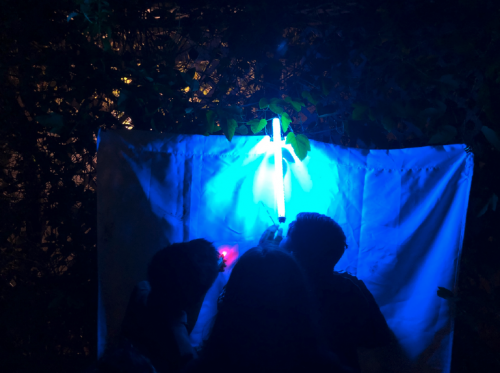Use lights to attract insects at night!
Observing Insects At Night Instructions
Ages: 5 and up
Time Required: 20-55 minutes
Materials
- An old white sheet (Substitute with any light-colored sheet, or even a light colored wall)
- A long piece of rope to hang your sheet on (optional)
- Clothes pins or binder clips to attach your sheet to the rope (optional)
- A black light/ultraviolet light (Substitute with a portable fluorescent light, incandescent light, camping lantern, or even car headlights!)
- A power source for your light if it’s not battery operated
Try This!

Step 1: Hang your sheet. It can be pinned or draped over rope that is tied tautly between two trees, fastened to the side of a wall, or hung from any other structure in your yard or balcony. No sheet? No worries! Use an outdoor wall instead.
Step 2: Hang your light in front of your sheet. A black light is great if you have one, but you can successfully attract insects with any bright light. Ideally, you’ll want to hang your light in front of the sheet (so it’s not sitting on the ground). You may need an extension cord if your light is not battery operated.
Step 3: Make a night of it! Set up some chairs and enjoy the night air as you observe your sheet, or just check in periodically. Different insects fly at different times throughout the night. What you attract right after nightfall will differ from the insects that visit your sheet in early morning.
Tips & Tricks
Even a bright porch light illuminating a wall can work in a pinch!
Night collecting works best when there is little competing light. Turn off all lights in and around your home, so that your collecting lamp is the only source of light.
Start your set-up at dusk so your sheet is ready to go once night falls.
Wear dark colored clothing so bugs are attracted to your sheet and not you.
Wear protective clothing and mosquito repellant if needed.
What’s Going On?
Insects navigate by the moon and the stars, and when they are flying round at night, they are keeping themselves on a steady course, keeping the moon always at a similar angle to their eyes. When we have a light on to attract them, they keep moving closer and closer to this light thinking they are keeping it at the same angle as if they were the moon or the stars in the sky. When they do this, they get confused and they start spinning to our lights.
Different kinds of insects come to different lights because insects are attracted to different wavelengths, and its typically UV that attracts them, and scientists usually set out these lights when there is no moon out at night. Once they land on your collecting sheets, they are a bit disoriented, and that gives us an opportunity to look at them. It is very important to remember that you should never leave lights on at night if you aren’t trying to attract insects, since light pollution is a really big problem right now, and lots of insects are dying because of many people leave their lights on all night. Insects are really important for pollination, they’re decomposers, and we get all kinds of fruits thanks to them.
Extension Activity
Use a website like iNaturalist.org to help you identify the insects that visit your light! Take pictures of them and post them on the iNaturalist website. By doing this you are helping scientists that study insects, and the iNaturalist community can also help you by identifying the insects for you.
Additional Resources
Learn more about collecting insects at night and learn how/why scientists look for bugs at night!